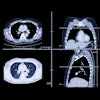Dear CT Insider,
Though still in its infancy in Asia, CT lung cancer screening has proved promising in several recent large-scale trials.
A recent study conducted by researchers from Massachusetts General Hospital offered additional support to that end. They used a computer-based model to simulate the widespread implementation of CT lung screening in China, Japan, Singapore, and South Korea -- the outcomes of which serve as the centerpiece of this edition's Insider Exclusive.
CT lung cancer screening continues to demonstrate its value in the U.S. and Europe as well. The latest update to the National Lung Screening Trial (NLST) showed a sustained reduction in lung cancer deaths even as much as 12 years after the initial screening exam. A secondary analysis of the Multicentric Italian Lung Detection (MILD) trial also confirmed that biennial CT lung screening was as effective as annual screening for individuals with negative baseline exams.
Still, there remains room for improvement for the test: Researchers from Duke University found that certain demographic factors -- including living in a rural area and not having insurance -- are associated with limited access to CT lung screening services; and a group from Tennessee uncovered a racial disparity in the current screening eligibility criteria recommended by the U.S. Preventive Services Task Force (USPSTF).
Yet the barriers facing CT lung screening pale in comparison to the state of pancreatic cancer screening. In a new recommendation statement, the USPSTF reaffirmed its prior decision to caution against using CT and other imaging modalities to screen for pancreatic cancer in asymptomatic individuals.
One of the task force's concerns with CT pancreatic cancer screening was the belief that the potential harms stemming from radiation exposure and subsequent treatment likely outweighed any benefits offered by the test. This growing unease with excessive CT radiation exposure is exemplified in a study that reported a notable increase in CT usage rates and, thus, radiation exposure for patients with kidney stones.
The upward trend in CT utilization has particularly disquieting ramifications for evaluating pregnant women. A team of investigators from California found that the overall rate of CT scans per patient has shot up by nearly fourfold in Canada and more than fivefold in the U.S. over the past two decades.
Numerous other stories are featured in the CT Community at AuntMinnie.com. Head on over to read about the capacity of CT to shed light on the Zika virus, cardiovascular mortality, the association between air pollution and lung disease, and more on the latest developments in the field.




















